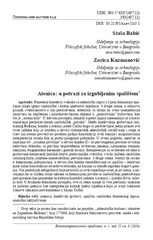Приказ основних података о документу
Atenica: in search of lost pyre
| dc.creator | Babić, Staša | |
| dc.creator | Kuzmanović, Zorica | |
| dc.date.accessioned | 2021-10-12T12:20:25Z | |
| dc.date.available | 2021-10-12T12:20:25Z | |
| dc.date.issued | 2016 | |
| dc.identifier.issn | 0353-1589 | |
| dc.identifier.uri | http://reff.f.bg.ac.rs/handle/123456789/2176 | |
| dc.description.abstract | Symbolic and cult practices of a community undoubtedly play an important role in the formation of funerary contexts. On the other hand, in the absence of written records on these practices, archaeologists are inclined to base their interpretations upon generalized and simplified ideas on "primitive cults", such as "solar cult". In this line of inference, technical aspects of the record are neglected in order to obtain the preconceived symbolic "messages". Among the princely graves of the Central Balkans, the mounds in Atenica near Cacak have long represented the only example of this type of funeral investigated in the course of systematic archaeological excavations; therefore, numerous researchers have devoted special attention to the construction of these tumuli and the possibilities of interpretation of the rites performed there. In this respect, special significance is assigned to the so-called "ritual area" of the mound II - three rectangular areas bordered by rows of pebbles, with conical pits filled by dark earth, fragments of pottery and burnt bones. The interpretations have ranged from the ideas about cremated human sacrifice, over a replica of a sanctuary, to the complex symbolic of solar cult, expressed in numeric regularities. On the other hand, since the buried individuals are cremated, the areas defined as funerary pyres have been identified in both mounds - relatively small crescent-shaped areas of pebbles with traces of burning. Practical incongruence stemming from this interpretation has remained unexplored, in the effort to link the complex ritual of cremation to the symbolic ideas perceived as appropriate for the cultural context of the Atenica burials - human sacrifice, solar cult. In the circular line of argument, more or less implicitly, these ideas have been applied as the starting premises for the wider interpretation of the cult practices of the community whose exceptional members were buried under the mounds near Cacak. | en |
| dc.publisher | Univerzitet u Beogradu - Filozofski fakultet - Odeljenje za etnologiju i antropologiju, Beograd | |
| dc.relation | info:eu-repo/grantAgreement/MESTD/Basic Research (BR or ON)/177008/RS// | |
| dc.rights | openAccess | |
| dc.rights.uri | https://creativecommons.org/licenses/by/4.0/ | |
| dc.source | Etnoantropološki problemi | |
| dc.subject | symbolics of funerary record | en |
| dc.subject | princely graves | en |
| dc.subject | funerary pyre | en |
| dc.subject | Atenica | en |
| dc.subject | analogic reasoning | en |
| dc.title | Atenica: in search of lost pyre | en |
| dc.type | article | |
| dc.rights.license | BY | |
| dc.citation.epage | 659 | |
| dc.citation.issue | 3 | |
| dc.citation.other | 11(3): 645-659 | |
| dc.citation.rank | M24 | |
| dc.citation.spage | 645 | |
| dc.citation.volume | 11 | |
| dc.identifier.doi | 10.21301/EAP.V11I3.1 | |
| dc.identifier.fulltext | http://reff.f.bg.ac.rs/bitstream/id/958/2173.pdf | |
| dc.identifier.wos | 000408769600001 | |
| dc.type.version | publishedVersion |

